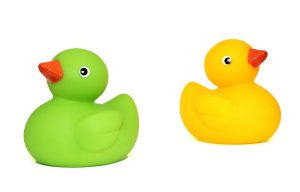When you are bathing your baby, it’s really important to put the cold water in first and THEN add the hot water until you get the right temperature. That way there will never be a bath full of very hot water which is a huge safety risk.

You can test the temperature of the bath by either using your elbow or the inside of your wrist, or you can use a specially designed baby thermometer that floats in your baby’s bath. Bath thermometers are available at most nursery stores.
Body temperature, or 37 degrees, is about the right temperature for the bath water. It can be lower than that, but no warmer. It will feel probably a bit cool to the baths you prefer but it’s important to remember that babies are less able to regulate their own body temperature and have a larger skin surface area.
If you have a bath with your baby it needs to be at their safe temperature, not your preferred temperature.
It is never safe to leave your baby alone in the bath, even for a second. Even if you’re using a bath seat that holds the baby upright because they can slip down into the water and drown. Babies won’t cry out for you to help them because they won’t realise that they’re in danger. So even though you might think I’m just going to nip out for a moment to get a dry towel, or answer the phone, babies can drown immediately and very silently.